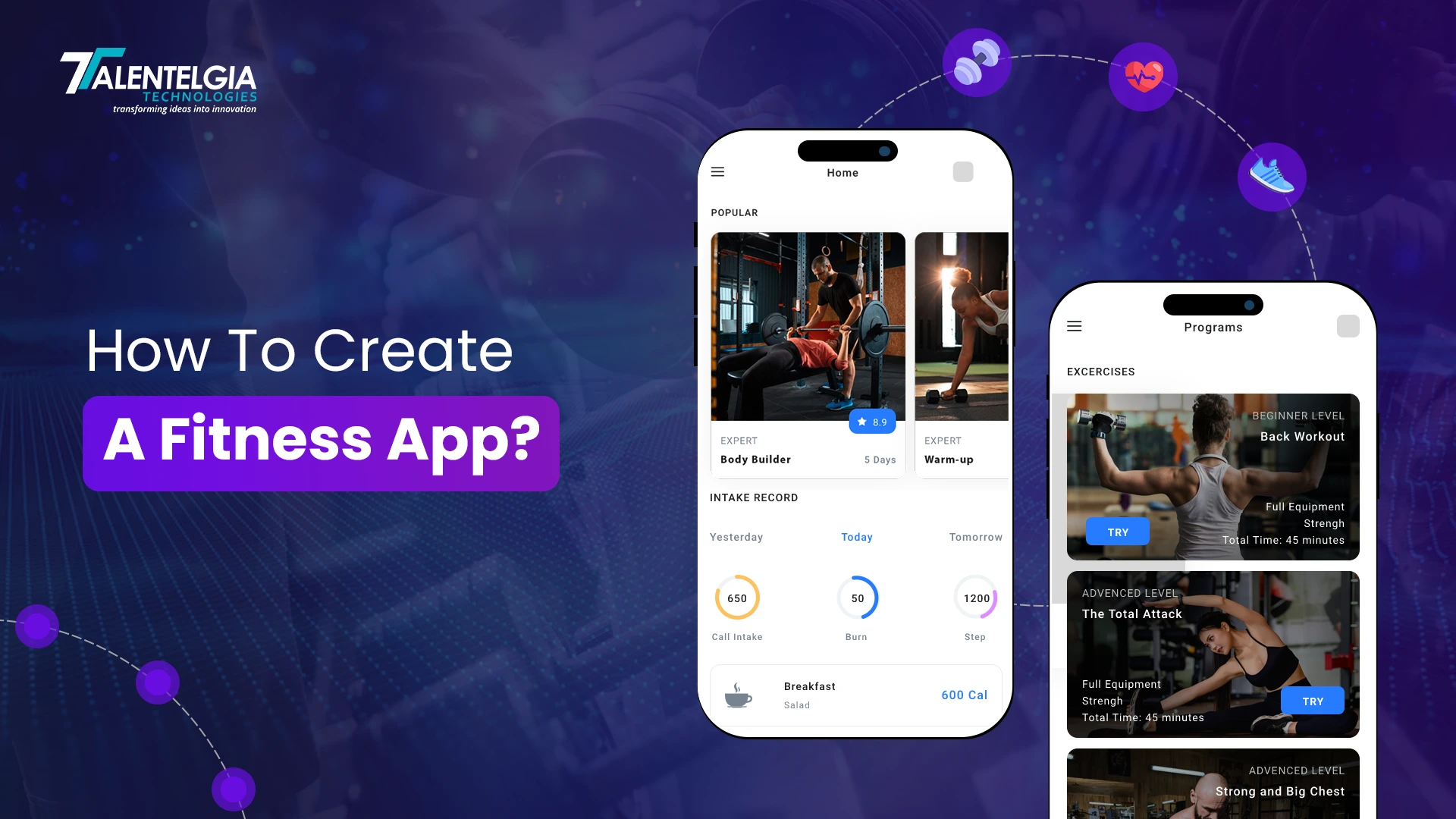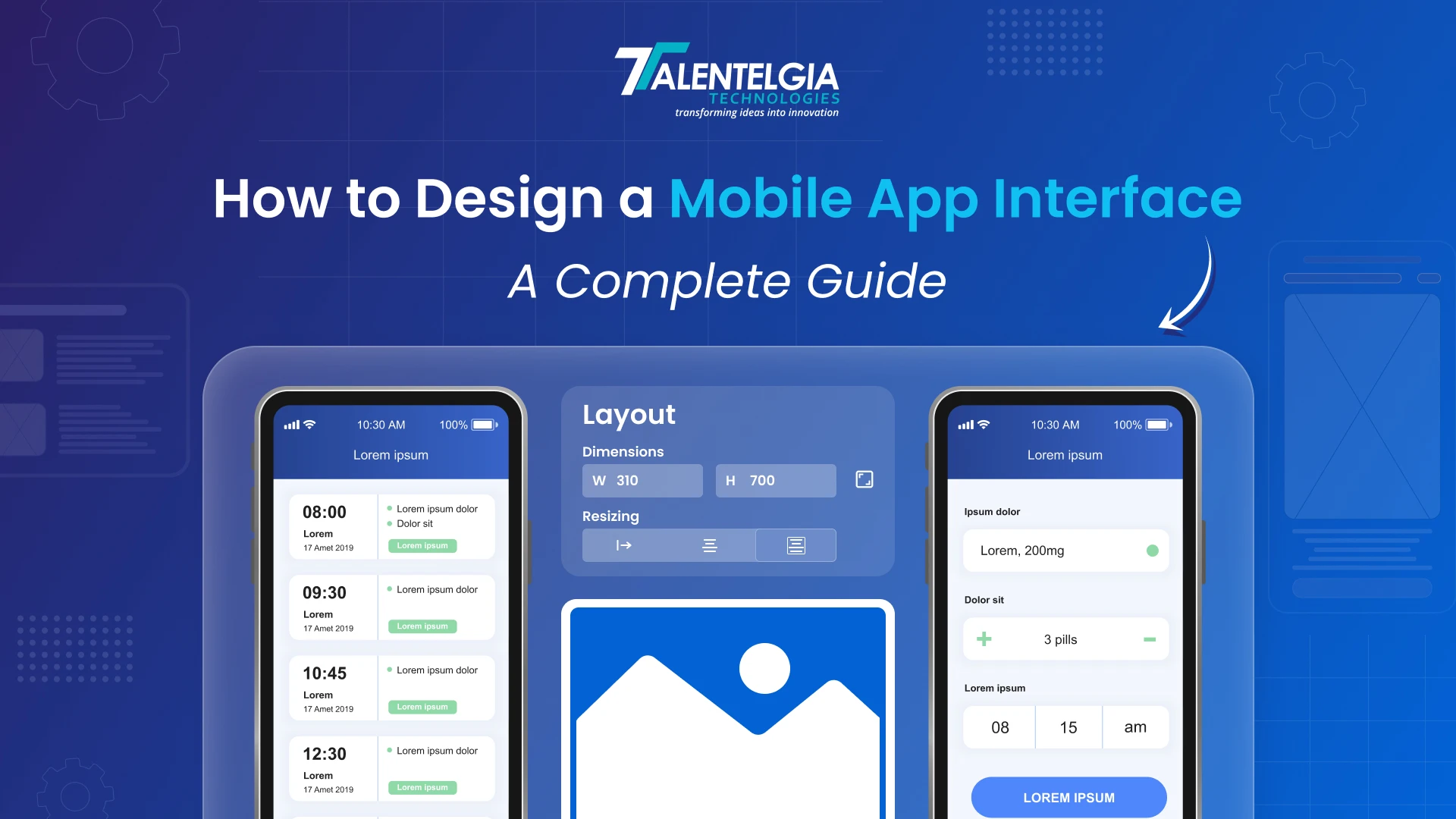The rising number of wearable devices has created an interest in fitness apps these days. Everyone wants to track their daily vitals including daily steps, breathing, pulse rate, and so on. This has created a buzz in the industry, pushing companies to innovate their existing products or create completely new ones. As a result, business leaders are introducing innovative fitness apps that measure health metrics and offer tailored fitness plans. Apps incorporating AI-driven coaching, social sharing, and gamification are being launched in the market. The competition is therefore strong and in such a scenario it becomes important for developers to get the basics on how to create a fitness app that not only engages the user but also builds long-term customer loyalty.
In this blog, we will lead you through a broad overview of how to create a fitness app. From ideation to development so that you can launch a product that stands out from your competitors.
Fitness App Development Process: Step-by-Step Guide
1. Conduct Thorough Market Research
A fundamental step to creating a fitness app is to conduct thorough market research. This involves gathering, analyzing, and interpreting information on the market, analyzing competitors, and the target users to align your needs with industry standards.
- Understand User Needs and Expectations: Once you have conducted thorough market research, you will know what the user is seeking from a fitness app. Conducting user surveys and attaining proper feedback on existing apps may uncover common pain points and desired functionalities, allowing you to design an all-user-centric app that will attract your audience. For example, if users complain about the interface of one app, you can take notes and make better design decisions while creating your fitness app.
- Differentiation Opportunity of Your App: Using the insights obtained from user preference and competitor analysis. A unique value proposition can be developed for your app. You can make your application stand out through innovative features, better user experiences, or even a more personalized form of fitness. If users value community interaction, incorporate social networking features that will allow users to connect, share progress, and participate in challenges.
2. Features and Functionality
After conducting deep market research and defining your goals for the fitness app, you must decide which features and functionalities to include. Choosing the right mix of features will drive user engagement, satisfaction, and long-term retention. Whether you are developing for Android or iOS app development, it’s crucial to ensure that the app performs seamlessly on both platforms.
An effective fitness app should feature programs that offer value to the user’s needs and preferences. Moreover, an application incorporating workouts and nutrition tracking provides value by allowing the user to personalize fitness as needed, which helps people stay engaged over time.
- Workout plans: Integrate personalization of workout plans that are designed and created according to a user’s fitness level and goals. Whatever the program, a weight loss, muscle gain, or endurance training program. Users love to have a structured plan with variations according to the individual’s performance. The ability to input workout recommendations dependent on user activity and preference could also increase engagement by giving them variety and challenges according to their improvement.
- Nutrition and Calorie Tracking: Nutrition tracking enables users to monitor their diet by setting up calorie goals and recording their meals. So they can stay on course with their fitness goals. This feature appeals quite vigorously to people who are currently in a weight management program or even a comprehensive health improvement program.
- Progress tracking: Probably one of the strongest motivations for a fitness enthusiast is the ability to track one’s development process. Well-defined features regarding tracking progress can visually show improvements in metrics such as weight, body measurements, or strength levels. Of course, this does not necessarily matter whether it goes through graphs, charts, or even achievement this keeps users encouraged and committed to their exercise routine by giving them tangible results.
- Social and Community Features: Building community is engaging more customers with your application. Social features like connecting friends, sharing results after workouts, or even joining group challenges allow for community and accountability. Many groups find motivation in competing or collaborating and cheering each other. This leads to more retention using the app and so much more enjoyment of the user experience.
3. Wireframes and Design
Creating a wireframe and design is an important step that creates the visual layout and flow of the app. Wireframes serve as blueprints that depict how features will be arranged from screen to screen. This step is important enough to ensure the user experience (UX) is intuitive, guiding users through the app effortlessly.
It further outlines how things like user profiles and tracking of progress are going to work together. Therefore, arrange these elements logically to ensure users can easily navigate the app without difficulty.
- User Experience (UX): This is where a hassle-free user experience is built. Any friction that the users may encounter in the course of usage must be removed. Conducting usability testing assures the developer that all main features will be available and that the app really feels easy to use. It saves time while developing because the problems identified are corrected at this point itself.
- Developing an Attractive User Interface(UI): Once you establish the focus, shift your attention to the user interface (UI). A beautiful design featuring clear icons, consistent typography, and a harmonized color scheme plays a significant role in attracting and retaining users.
4. Choose a suitable technology stack
The right selection of the technology stack determines how well an app is going to work and grow over time. Frontend solutions relate to what users see when they visit the application. Whereas backend solutions relate to what runs behind the scenes.
- Native vs. Cross-Platform Development: A native build means the app for each platform is different because it allows high performance but is more challenging and expensive. Whereas, Cross-platform app development, enables you to create one app that can work for both platforms, saving a lot of time and money while significantly increasing your audience base.
- Backend for Smooth Function: The backend handles important tasks like user authentication, data management, and ensuring the app runs smoothly. A good strong backend will ensure that everything works as smoothly and nicely even as the application grows.
5. Building the App
The development stage is important because developers build both the front-end and back-end of the app to ensure they complement each other seamlessly. Here’s how it usually goes:
- Front-end Development: The main intention in front-end development is to design the user interface of the application and then make it more user-friendly with a high UX. This requires designing the layout, ensuring faster loads for the application, and ensuring accessibility to navigation through the application.
- Backend Development: On the backend side, it’s all about designing the servers, managing the databases, and handling information related to users. This part of the development also makes sure that security measures are there. Like encryption and user authentication, so secure and sensitive information does not go into the wrong hands, and it culminates in a reliable app.
6. Test your application thoroughly.
Testing is essential to ensure the app works properly and also provides the user with a pleasant experience. Stringent testing can eliminate problems that can occur after the launch. Functional testing ensures that all the features of the application are working as intended. Usability testing, on the other hand, collects opinions from users regarding the ease of use. It’s through performance testing that you get to know how your app will perform under various conditions. Security testing, on the other hand, has to be ensured about health-related apps where user details are strictly protected.
7. App Launch and user feedback
This will certainly be the most critical stage for your application. Develop a highly attractive application store listing. Include useful, rich visual content and descriptions that will draw users to your application. Clearly describe its core feature sets and benefits.
After launching, gather feedback from users to further improve the application. Surveys, reviews, and analytics of an app help individuals understand the user experience and trends. They identify areas for improvement that can guide future upgrades, ensuring that the application remains relevant and easy to use.
Conclusion
Creating a successful fitness app is an exciting journey that starts with understanding your market and user needs not just at the concept stage but even post-launch. Every single step, whether it's defining essential features or selecting the right technology stack, is going to be crucial to making the app user-friendly and engaging.
Besides the technological aspect, developing a community around your application makes it easier to retain and motivate users. It is also important to keep adapting and changing your application according to shifts in the user base's needs and desires. Finally, a thoughtful design, thorough functionality, and continuous improvement will further propel your fitness app forward to success in the competitive market.


 Healthcare App Development Services
Healthcare App Development Services
 Real Estate Web Development Services
Real Estate Web Development Services
 E-Commerce App Development Services
E-Commerce App Development Services E-Commerce Web Development Services
E-Commerce Web Development Services Blockchain E-commerce Development Company
Blockchain E-commerce Development Company
 Fintech App Development Services
Fintech App Development Services Fintech Web Development
Fintech Web Development Blockchain Fintech Development Company
Blockchain Fintech Development Company
 E-Learning App Development Services
E-Learning App Development Services
 Restaurant App Development Company
Restaurant App Development Company
 Mobile Game Development Company
Mobile Game Development Company
 Travel App Development Company
Travel App Development Company
 Automotive Web Design
Automotive Web Design
 AI Traffic Management System
AI Traffic Management System
 AI Inventory Management Software
AI Inventory Management Software
 AI Software Development
AI Software Development  AI Development Company
AI Development Company  AI App Development Services
AI App Development Services  ChatGPT integration services
ChatGPT integration services  AI Integration Services
AI Integration Services  Generative AI Development Services
Generative AI Development Services  Natural Language Processing Company
Natural Language Processing Company Machine Learning Development
Machine Learning Development  Machine learning consulting services
Machine learning consulting services  Blockchain Development
Blockchain Development  Blockchain Software Development
Blockchain Software Development  Smart Contract Development Company
Smart Contract Development Company  NFT Marketplace Development Services
NFT Marketplace Development Services  Asset Tokenization Company
Asset Tokenization Company DeFi Wallet Development Company
DeFi Wallet Development Company Mobile App Development
Mobile App Development  IOS App Development
IOS App Development  Android App Development
Android App Development  Cross-Platform App Development
Cross-Platform App Development  Augmented Reality (AR) App Development
Augmented Reality (AR) App Development  Virtual Reality (VR) App Development
Virtual Reality (VR) App Development  Web App Development
Web App Development  SaaS App Development
SaaS App Development Flutter
Flutter  React Native
React Native  Swift (IOS)
Swift (IOS)  Kotlin (Android)
Kotlin (Android)  Mean Stack Development
Mean Stack Development  AngularJS Development
AngularJS Development  MongoDB Development
MongoDB Development  Nodejs Development
Nodejs Development  Database Development
Database Development Ruby on Rails Development
Ruby on Rails Development Expressjs Development
Expressjs Development  Full Stack Development
Full Stack Development  Web Development Services
Web Development Services  Laravel Development
Laravel Development  LAMP Development
LAMP Development  Custom PHP Development
Custom PHP Development  .Net Development
.Net Development  User Experience Design Services
User Experience Design Services  User Interface Design Services
User Interface Design Services  Automated Testing
Automated Testing  Manual Testing
Manual Testing  Digital Marketing Services
Digital Marketing Services 
 Ride-Sharing And Taxi Services
Ride-Sharing And Taxi Services Food Delivery Services
Food Delivery Services Grocery Delivery Services
Grocery Delivery Services Transportation And Logistics
Transportation And Logistics Car Wash App
Car Wash App Home Services App
Home Services App ERP Development Services
ERP Development Services CMS Development Services
CMS Development Services LMS Development
LMS Development CRM Development
CRM Development DevOps Development Services
DevOps Development Services AI Business Solutions
AI Business Solutions AI Cloud Solutions
AI Cloud Solutions AI Chatbot Development
AI Chatbot Development API Development
API Development Blockchain Product Development
Blockchain Product Development Cryptocurrency Wallet Development
Cryptocurrency Wallet Development About Talentelgia
About Talentelgia  Our Team
Our Team  Our Culture
Our Culture 
 Healthcare App Development Services
Healthcare App Development Services Real Estate Web Development Services
Real Estate Web Development Services E-Commerce App Development Services
E-Commerce App Development Services E-Commerce Web Development Services
E-Commerce Web Development Services Blockchain E-commerce
Development Company
Blockchain E-commerce
Development Company Fintech App Development Services
Fintech App Development Services Finance Web Development
Finance Web Development Blockchain Fintech
Development Company
Blockchain Fintech
Development Company E-Learning App Development Services
E-Learning App Development Services Restaurant App Development Company
Restaurant App Development Company Mobile Game Development Company
Mobile Game Development Company Travel App Development Company
Travel App Development Company Automotive Web Design
Automotive Web Design AI Traffic Management System
AI Traffic Management System AI Inventory Management Software
AI Inventory Management Software AI Software Development
AI Software Development AI Development Company
AI Development Company ChatGPT integration services
ChatGPT integration services AI Integration Services
AI Integration Services Machine Learning Development
Machine Learning Development Machine learning consulting services
Machine learning consulting services Blockchain Development
Blockchain Development Blockchain Software Development
Blockchain Software Development Smart contract development company
Smart contract development company NFT marketplace development services
NFT marketplace development services IOS App Development
IOS App Development Android App Development
Android App Development Cross-Platform App Development
Cross-Platform App Development Augmented Reality (AR) App
Development
Augmented Reality (AR) App
Development Virtual Reality (VR) App Development
Virtual Reality (VR) App Development Web App Development
Web App Development Flutter
Flutter React
Native
React
Native Swift
(IOS)
Swift
(IOS) Kotlin (Android)
Kotlin (Android) MEAN Stack Development
MEAN Stack Development AngularJS Development
AngularJS Development MongoDB Development
MongoDB Development Nodejs Development
Nodejs Development Database development services
Database development services Ruby on Rails Development services
Ruby on Rails Development services Expressjs Development
Expressjs Development Full Stack Development
Full Stack Development Web Development Services
Web Development Services Laravel Development
Laravel Development LAMP
Development
LAMP
Development Custom PHP Development
Custom PHP Development User Experience Design Services
User Experience Design Services User Interface Design Services
User Interface Design Services Automated Testing
Automated Testing Manual
Testing
Manual
Testing About Talentelgia
About Talentelgia Our Team
Our Team Our Culture
Our Culture

















 Write us on:
Write us on:  Business queries:
Business queries:  HR:
HR: 





